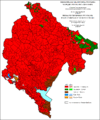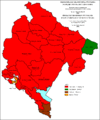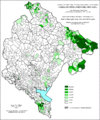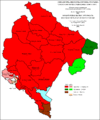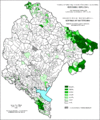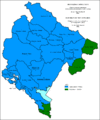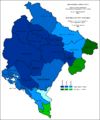- Demographic history of Montenegro
-

This article is part of the series:
Montenegro- History
- Politics
- President
- Prime Minister
- Government
- Parliament
- Elections
- Foreign relations
- Subdivisions
- Economy
- Military
- Communications
- Culture
- Demographics
- Demographic history
- Transportation
- Geography
See also: Portal:Politics
This article presents the demographic history of Montenegro through census results and official documents which mention demographic composition. See Demographics of Montenegro for a more detailed overview of the current demographics of Montenegro.
Contents
Medieval
Duklja, today's southern half of Montenegro, under Stefan Vojislav, was inhabited by Serbs.[1]
Various documents listed that the inhabitants of Medieval Doclea or Zeta were Serbs,, but also minor populations of Latins, Albanians and Vlachs. The language in usage was primarily the Serbian dialect of Old Slavonic, while in the early stages Latin also had importance and Greek to an extent among the high-class members of the society.
Between the 15th and 17th century, Montenegro had little history on paper, however it is said that the Montenegrin population never exceeded 10 000.[citation needed] During these years, hundreds of families of Bosnian- and Rascian Serbs sought refuge in the highlands of Montenegro.[citation needed] Medieval documents state that the citizens of Montenegro were Serbs.[citation needed]
1614
Mariano Bolizza of Kotor was a public servant of the Republic of Venice. The main objective of his 1614 report and description of the Sanjak of Shkodra was to provide information on the land routes which could best be utilized by local couriers conveying official correspondence from Venice to Constantinople and back, and to survey the military potential of the territory. He provided a very detailed overview of towns and villages in Montenegro and northern Albania in the early 17th century. The report concluded an ethnic Serb majority, while an Albanian minority was present in the Shkodra region.[2]
18th century
The ethnic composition in the 18th century was clear among the Slavs;
- In a letter to Justinian Bert in 1756, Montenegrin chieftains said: "We are of the Orthodox Christian faith and law of the Eastern Church, of the honorable and glorious Slav-Serb kin".
- Jovan Stefanov Balevic, of the Bratonozic clan, who later became a major in the Russian army, wrote "A brief and objective description of the present state of Montenegro"[3] in St. Petersburg in 1757, where it said: "All inhabitants of Montenegro are ethnically Serbs and confessionally Orthodox. As they are incompetent in some skills, because of their lack of school, they are naturally capable, especially with weapons."[3];
- "The number of Montenegrin warriors who live free on the peaks of Montenegro, called by Turks disobedient, does not exceed 5000."[3]
- "There are no artisans and schools in Montenegro except at the Cetinje monastery, within the archbishop's residence, where priests learn reading and writing in the Slav-Serb language, which is financed by the archbishop."
- "Montenegrins count among themselves neighbouring Slav-Serbs of different provenience: Kuci, Bratonozici, Donji and Gornji Vasojevici, Piperi, Rovcani, Moracani, Bjelopavlici, who are Serb Orthodox but Ottoman citizens. They, also, count Roman Catholics: Hoti, Klimenti, Grudi, Tuzi, Skrivali, Huzi, Maltezi, Kastrati and others who outnumber Montenegrins." [3]
- In June 1789, Montenegrin Chieftains, wrote to Russian Empress Katarina II, in the name of the entire Serb Montenegrin community: "We Serbs Montenegrins hope that we shall not be left without help" and "If we could have organization and munition, we would liberate our glorious Serb lands entirely from the Barbarian yoke (Ottoman Empire), together with our armed Serb brothers who aim to attack this enemy from all sides.
19th century
- According to letters to Russia from Bishop Petar I Petrović Njegoš from March 5, 1826, "the people of Montenegro are Serb of the Orthodox Christian faith".
- According to "paragraph 92" in the code of Prince Danilo, established 1855: "Although there is no other nationality in this land except Serb nationality and no other religion except Eastern Orthodoxy..." and about Serbdom: "...of our homogenous Serb nation. the Montenegrin prince has, in his heart, carved sense of love and devotion not only towards his people, but towards entire Serbdom and everything named and called - Serb."[4]
- Schwartz estimated in 1882 that the Princedom of Montenegro had 160,000 inhabitants. Although, a more usual estimate is that it was around 230,000 inhabitants.
- In 1895, the inhabitants of Montenegro was said to be "pure Serbs" because who speak Serbian language and followers of the Eastern Orthodox Church. There was a Catholic and Muhammedan minority.[citation needed]
1900
In 1900, according to international sources, the Principality of Montenegro had 311,564 inhabitants. By religion:
- 293,527 Serbian Orthodox (94,21%)
- 12,493 Muslims (4,01%)
- 5,544 Roman Catholic (1,78%)
By literacy:
- 77% illiterate
- 71,528 (23%) literate
The Princedom had around 5,000 Albanians and a colony of 800 Romas.
1905
This year there were 6,674 emigrants, mostly to the United States.
1906
This year there were 4,346 emigrants, mostly to the United States.
1907
It has been estimated that there were around 282,000 inhabitants in Montenegro this year.
1909
 Map from 1910
Map from 1910
Dark - Serbs; Light - AlbaniansThe 1909 official census was undertaken by the authorities of the Principality of Montenegro. Ethnicity was decided according to the mother tongue and religion, the official language being the Serbian language:
Total: 317,856 inhabitants. By language:
By religion:
- Orthodox Christians: 94.38%
- others (mostly Muslims)
Conclusion:
- Serbs speaking the Serbian language (Orthodox Christians): ~95%
- Others (Muslims; Albanians): ~5%
1911
In 1911, the population of Montenegro had risen to 211,909.[5]
In a geographic textbook for Montenegrin 3rd graders of elementary school, it was written that:
"In Montenegro live only true and pure Serbs who speak Serbian language... Besides Montenegro there are more Serb lands in which our Serb brothers are living... Some of them are free as we are and some subjugated to foreigners[...] Each Serb in Montenegro is obligated to love his entire Fatherland, all Serb lands - in which our free and unfree Serb brothers are living."[6]
1914
The Cetinje government stated in the Code of Law in 1914 that there are around 500,000 citizens of Montenegro. It was declared that the term Montenegrin people can only refer to all citizens of the Kingdom of Montenegro, since a Montenegrin ethnicity doesn't exist and Montenegrins are ethnic Serbs.
1921
In 1918 Montenegro entered the Kingdom of Serbs, Croats and Slovenes. In 1921 it organised a census which recorded the mother tongue and religion. A category called Serbian or Croatian was to include all respondents who termed their mother tongue as Serbian.[citation needed] In the counties Andrijevica, Bar, Kolasin, Niksic, Podgorica and Cetinje, which are categorized in official statistics as Montenegro, there were:
Total: 199,227 inhabitants
- Serbian or Croatian: 181,989 (91.35%)
- Albanian: 16,838 (8.45%)
The counties Berane and Bijelo Polje, which are today in Montenegro, were considered counties of Old Serbia:
- Berane, total 23,864 inhabitants, Serbs 23,561 or (98.73%)
- Bijelo Polje, total 26,147 inhabitants, Serbs 26,136 (99.96%)
Summed results:
Total: 249,238 inhabitants
- Serbs or Croats: 231,686 (92.96%)
- others, mostly Albanians
Total population for the area of modern-day Montenegro in precise was 311,341.
1931
The 1931 census was also taken by the Kingdom of Yugoslavia but was later processed in Communist Yugoslavia. Results within today's borders of Montenegro were:
Total: 360,044 inhabitants :Serbian Orthodox: 272,702 (80.88%) :Roman Catholics: 26,070 (7.24%) :Muslims 61,038 (16.96%)
:Serbian, Croatian and Slovenian languages: 339,955 (90.13%) :Albanian language: 18,098 (5.03%)
1948
In 1945, after the World War II, Communist Yugoslavia was formed, and Montenegro was proclaimed as one of its constituent republics. The 1948 and following censa were taken by the Republic of Montenegro.
Total: 377,189 inhabitants :Montenegrins: 342,009 (90.67%) :Albanians: 19,425 or (5.15%) :Croats: 6,808 or (1.8%) :Serbs: 6,707 or (1.78%) :Undecided Muslims: 387 (0.1%) :Others: 1860 or (0.52%) ::Slovenes: 484 ::Germans: 375 ::Russians: 277 ::Italians: 162 ::Roma: 162 ::Macedonians: 133 ::Czechs: 93 ::Hungarians: 62
1953
The 1953 census results:
Total: 419,873 inhabitants :Montenegrins: 363,686 (86.61%) :Albanians: 23,460 (5.58%) :Serbs: 13,864 (3.3%) :Croats: 9,814 (2.33%) :Yugoslavs: 6,424 (1.52%) :Others: 2,625 (0.66%)
This census witnesses the forming of the Yugoslav nation.
1961
The 1961 census results:
Total: 471,894 inhabitants :Montenegrins: 383,988 (81.37%) :Muslims: 30,665 (6.5%) :Albanians: 25,803 (5.47%) :Serbs: 14,087 (2.99%) :Croats: 10,664 (2.26%) :Yugoslavs: 1,559 (0.33%)
In 1968 the Communist Yugoslav government introduced a new category, Muslims by nationality.
1971
The 1971 census results:
Total 529,604 inhabitants :Montenegrins: 355,632 (67.15%) :Muslims: 70,236 (13.26%) :Serbs: 39,512 or (7.46%) :Albanians: 35,671 (6.74%) :Yugoslavs: 10,943 (2.07%) :Croats: 9,192 (1.74%)
1981
The 1981 census results:
Total: 584,310 inhabitants :Montenegrins: 400,488 (68.54%) :Muslims: 78,080 (13.36%) :Albanians: 37,735 (6.46%) :Yugoslavs: 31,243 (5.35%) :Serbs: 19,407 (3.32%) :Croats: 6,904 (1.81%) :Roma: 1,471 (0.25%) :Macedonian: 875 (0.15%) :Slovenes: 564 (0.1%) :Hungarians: 238 (0.04%) :Germans: 107 (0.02%) :Russians: 96 (0.02%) :Italians: 45 (0.01%) :Other: 816 (0.14%) :No response: 301 (0.05%) :Regional affiliation: 1,602 (0.27%) :Unknown: 4,338 (0.74%)
1991
The 1991 census results:
Total: 615,035 inhabitants
Ethnic structure
:Montenegrins: 380,467 (61.86%) :Muslims: 89,614 (14.57%) :Serbs: 57,453 (9.34%) :Albanians: 40,415 (6.57%) :Yugoslavs: 26,159 (4.25%) :Croats: 6,244 (1.02%) :Roma: 3,282 (0.53%) :Macedonian: 1,072 (0.17%) :Slovenes: 369 (0.06%) :Hungarians: 205 (0.03%) :Germans: 124 (0.02%) :Russians: 118 (0.02%) :Italians: 58 (0.01%) :Other: 437 (0.07%) :No response: 1,944 (0.32%) :Regional affiliation: 998 (0.16%) :Unknown: 6,076 (0.99%)
Linguistic structure
- Serbian: 510,320
- Montenegrin: 144,838
- Albanian: 43,907
- 40,008 Muslims declared their language to be Serbian, while most declared either Bosniak or Bosnian languages as their mother tongue
Religious structure
- Eastern Orthodox - 425,133
- Montenegrins - 241,728
- Serbs - 196,333
- Muslims - 118,016
- Albanians - 26,216
- Montenegrins - 82,492
- Yugoslavs - 1,856
- Catholic - 27,153
- Albanians - 12,772
- Yugoslavs - 4,149
- Montenegrins - 3,081
2003
The 2003 census was undertaken by authorities in Montenegro, which at this time, together with Serbia, constituted Serbia and Montenegro.
Total: 620,145
Ethnic structure
- Montenegrins 267,669 (43.16%)
- Serbs 198,414 (31.99%)
- Bosniaks 48,184 (7.77%)
- Albanians 31,163 (5.03%)
- Muslims 24,625 (3.97%)
- Croats 6,811 (1.1%)
- Roma 2,601 (0.42%)
- Yugoslavs 1,860 (0.3%)
- Macedonians 819 (0.13%)
- Slovenes 415 (0.07%)
- Hungarians 362 (0.06%)
- Russians 240 (0.04%)
- Egyptians 225 (0.04%)
- Italians 127 (0.02%)
- Germans 118 (0.02%)
- Others (i.e. Greeks, Turks, Romanians, Bulgarians) 2,180 (0.35%)
- No response 26,906 (4.34%)
- Regional affiliation 1,258 (0.2%)
- Unknown 6,168 (0.99%)
This census witnessed the forming of the Bosniak nation, but some people still thought of themselves Muslims by nationality, however. Also, there are very few people left who consider themselves Yugoslavs. But the biggest difference compared to the 1991 census is the dramatic increase in self-identification of many inhabitants as Serbs, which was not the case in Socialist Yugoslavia.
Linguistic structure
- Serbian - 393.740 (63,49%)
- Montenegrin: 136.208 (21,96%)
- Albanian - 32.603 (5,26%)
- Bosniak - 19.906 (3,21%)
- Bosnian - 14.172 (2,29%)
- Croatian - 2.791 (0,45%)
- Roma - 2.602 (0,42%)
- undeclared: 13.902 (2,24%)
Religious structure
2011
Total: 620,029
Ethnic structure
- Montenegrins 278,865 (44.98%)
- Serbs 178,110 (28.73%)
- Bosniaks 53,605 (8.65%)
- Albanians 30,439 (4.91%)
- Muslims 20,537 (3.31%)
- Roma 6,251 (1.01%)
- Croats 6,021 (0.97%)
- Others 46,201 (7.44%)
Linguistic structure
- Serbian: 265,895 (42.88%)
- Montenegrin: 229,251 (36.97%)
- Bosnian: 33,077 (5.33%)
- Albanian: 32,671 (5.27%)
- Rhoma: 5,169 (0.83%)
- Bosniak: 3,662 (0.59%)
- Croatian: 2,791 (0.45%)
- Others: 47,513 (7.68%)
Religious structure
- Eastern Orthodox - 446,858 (72.07%)
- Muslims - 118,477 (19.11%)
- Catholic - 21,299 (3.44%)
- Others 27,756 (5.38%)
Sources
- Montenegrin Census' from 1909 to 2003
- The Ethnic Structure of the Population in Montenegro
- "Petar I Petrovic' - DJELA" publisher CID Podgorica 1999 year, printed by "Vojna tamparija" - Beograd
- "Statistički Godišnjak 2006" - Statistical Office of Montenegro
References
- ^ The Early Medieval Balkans by John Van Antwerp Fine, 1983
- ^ http://www.montenegrina.net/pages/pages_e/history/report_and_description_of_the_sanjak_of_shkodra1614.htm
- ^ a b c d Short historic-geographical description of Montenegro- Jovan Stefanov Balevic
- ^ Montenegrin Chieftains - Serbian Patriots
- ^ Palairet, Michael (1997). The Balkan Economies C.1800-1914: Evolution Without Development. Cambridge University Press. ISBN 052158051X. http://books.google.co.uk/books?id=hkQytxTkZcoC&pg=PA15&dq=1911+population+of+montenegro&hl=en&ei=RtbjTJrIGpOKhQeRt7GrDg&sa=X&oi=book_result&ct=result&resnum=1&ved=0CDgQ6AEwAA#v=onepage&q=1911%20population%20of%20montenegro&f=false.
- ^ Education in Montenegro
Ethnic groups of Montenegro Montenegrins · Serbs · Albanians · Bosniaks(+Muslims by nationality) · Croats · Macedonians · Roma (+Ashkali) · Turks · YugoslavsSee also: Demographics · Demographic historyDemographic history of Europe Sovereign
states- Albania
- Andorra
- Armenia
- Austria
- Azerbaijan
- Belarus
- Belgium
- Bosnia and Herzegovina
- Bulgaria
- Croatia
- Cyprus
- Czech Republic
- Denmark
- Estonia
- Finland
- France
- Georgia
- Germany
- Greece
- Hungary
- Iceland
- Ireland
- Italy
- Kazakhstan
- Latvia
- Liechtenstein
- Lithuania
- Luxembourg
- Macedonia
- Malta
- Moldova
- Monaco
- Montenegro
- Netherlands
- Norway
- Poland
- Portugal
- Romania
- Russia
- San Marino
- Serbia
- Slovakia
- Slovenia
- Spain
- Sweden
- Switzerland
- Turkey
- Ukraine
- United Kingdom
- (England
- Northern Ireland
- Scotland
- Wales)
States with limited
recognition- Abkhazia
- Kosovo
- Nagorno-Karabakh
- Northern Cyprus
- South Ossetia
- Transnistria
Dependencies
and other territories- Åland
- Faroe Islands
- Gibraltar
- Guernsey
- Jan Mayen
- Jersey
- Isle of Man
- Svalbard
Other entities Categories:
Wikimedia Foundation. 2010.


